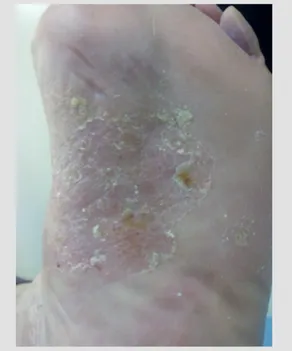European Journal
of Case Reports in
Internal Medicine
DOI: 10.12890/2019_001458 European Journal of Case Reports in Internal Medicine © EFIM 2020
Doi: 10.12890/2020_001458 - European Journal of Case Reports in Internal Medicine - © EFIM 2020
Turicella otitidis as an Unusual Agent Causing Palmoplantar Eczema:
An Emerging Pathogen
Dimitra Koumaki1, Vasiliki Koumaki2, Sotirios Boumpoucheropoulos3, Alexander Katoulis4, Panagiotis Bitados5,
Maria Stefanidou1, Konstantinos Krasagakis1
1Dermatology Department, University Hospital of Heraklion, Crete, Greece 2Microbiology Department, Medical School of Athens, Greece
3Department of Medical Oncology, Agioi Anargyroi, General Oncological Hospital, Athens, Greece
42nd Department of Dermatology and Venereology, National and Kapodistrian University of Athens, Medical School, “Attikon” General University Hospital 5Medical School of Crete, Heraklion, Crete, Greece
Received: 30/12/2019 Accepted: 10/01/2020 Published: 10/02/2020
How to cite this article: Koumaki D, Koumaki V, Boumpoucherpopoulos S, Katoulis A, Bitados P, Stefanidou M, Krasagakis K. Turicella otitidis as an usual agent causing palmolantar eczema: an emerging pathogen. EJCRIM 2020;7: doi:10.12890/2020_001458.
Conflicts of Interests: The Authors declare that there are no competing interest This article is licensed under a Commons Attribution Non-Commercial 4.0 License
ABSTRACT
Introduction: Turicella otitidis, described as a new species over 20 years ago, has been isolated mainly from the external ear canal and middle ear fluid. Here, we report the first case of palmoplantar eczema related to T. otitidis.
Case presentation: Here, we report the first case of palmoplantar eczema in a 74-year-old female related to T. otitidis.
Conclusions: The question as to whether T. otitidis is a potential pathogen in cases of dyshidrotic eczema is still open, but this could be better elucidated if corynebacteria were speciated more often.
LEARNING POINTS
• The coryneform bacteria Turicella otitidis and Corynebacterium auris were recently detected for the first time in the middle ear of patients with acute otitis media and chronic otitis media.
• T. otitidis is a potential extraotic pathogen.
• T. otitidis may be implicated in the pathogenesis of palmoplantar dermatitis.
KEYWORDS
Palmoplantar dermatitis, eczema, Turicella otitis, Corynebacteria
CASE DESCRIPTION
Turicella otitidis (T. otitidis), a coryneform Gram-positive bacterium, was initially isolated from middle ear fluid from children with otitis media in Switzerland [1]. It differs from most corynebacteria in lacking mycolic acids and in producing the major menaquinones MK-10 and
MK-11[2]. A study of the skin microbiome showed that corynebacteria predominated on moist skin sites but also occurred together with
propionibacteria and staphylococci on sebaceous sites[3]. Previous published cases suggest that T. otitidis is a potential extraotic pathogen[4,5].
Here, we report the first case of palmoplantar eczema due to T. otitidis.
A 74-year-old female was seen in September 2018 with hyperkeratosis, cracking and blistering of the skin on the palms of her hands and the soles of her feet that had developed over a 3-week period with no specific cause. The clinical presentation was more in keeping with palmoplantar eczema (Fig. 1).
European Journal
of Case Reports in
Internal Medicine
DOI: 10.12890/2019_001458 European Journal of Case Reports in Internal Medicine © EFIM 2020
Figure 1. Dermatitis on the soles of the patient
The patient had no past medical history of atopy. She was initially treated with topical emollients, isoconazole nitrate and diflucortolone valerate cream once daily for 2 weeks and aciclovir cream 5 times a day for 5 days with moderate improvement. A skin swab that was taken from the blisters of her soles grew Staphylococcus epidermidis (S. epidermidis) with a positive cefoxitin screen test, that was resistant to penicillin G and oxacillin but sensitive to erythromycin, clindamycin and linezolid, and Turicella otitidis that was sensitive to cefoxitin, cefotaxime, piperacillin/tazobactam and linezolid but resistant to gentamicin, neomycin, vancomycin, erythromycin and clindamycin. Bacteria were identified by conventional biochemical tests and by the VITEK® 2 automated system. Cefuroxime 500 mg twice daily for 7 days was also prescribed to the patient. At her follow-up appointment, after 2 weeks, there was a great improvement in her eczema.
DISCUSSION
T. otitidis clusters within the boundaries of the genus Corynebacterium, along with the amycolate species Corynebacterium amycolatum[2]. In
addition to otitis media, it has been associated with mastoiditis, otorrhoea and posterior auricular abscess in children[3–5]. T. otitidis has so far
been susceptible to many antimicrobials, with surprisingly low MIC 90 values for penicillins, cephalosporins, carbapenems, chloramphenicol, ciprofloxacin, aminoglycosides, rifampicin, tetracyclines, linezolid, teicoplanin and vancomycin; the only exceptions being clindamycin and erythromycin[3]. It seems strange that, 26 years after T. otitidis was outlined as a species, only a few cases of isolation have been reported in
the literature. This may be due to the difficulty in diagnosing this species but it could also be ascribed to the still widely held opinion that there is no value in diphtheroids being speciated[3]. To the best of our knowledge, this is the first reported case of palmoplantar eczema
related to T. otitidis. In our case, the question of whether T. otitidis is a mere colonizer or a potential pathogen in cases of dyshidrotic eczema cannot be answered unequivocally at this time. The possibility of its pathogenic potential is still open but this could be better elucidated if corynebacteria were to be speciated more often.
REFERENCES
1. Funke G, Stubbs S, Altwegg M, Carlotti A, Collins MD. Turicella otitidis gen. nov., sp. nov., a coryneform bacterium isolated from patients with otitis media. Int J Syst Bacteriol 1994;44:270–273.
2. Brinkrolf K, Schneider J, Knecht M, Rückert C, Tauch A. Draft genome sequence of Turicella otitidis ATCC 51513, isolated from middle ear fluid from a child with otitis media. J
Bacteriol 2012;194(21):5968–5969.
3. von Graevenitz A, Funke G. Turicella otitidis and Corynebacterium auris: 20 years on. Infection 2014;42(1):1–4.
4. Jeziorski E, Marchandin H, Jean-Pierre H, Guyon G, Ludwig C, Lalande M, et al. [Turicella otitidis infection: otitis media complicated by mastoiditis]. Arch Pediatr 2009;16(3):243– 247.
